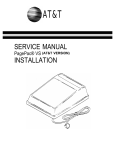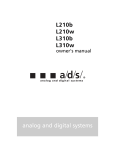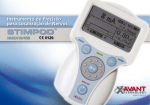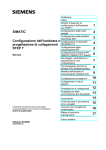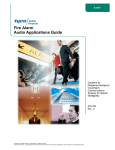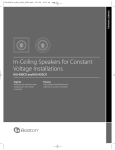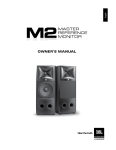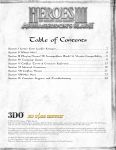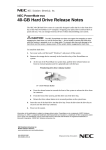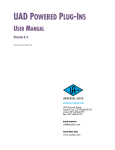Download AT&T - Avaya Support
Transcript
AT&T ® PagePac 20 Voice Paging System PowerMate™ Service Manual—Installation ® PagePac 20 Voice Paging System PowerMate™ Service Manual—Installation SM-722050-001 999-500-200IS Issue 4, Nov. 1987 HARRIS CORPORATION Dracon Division 809 Calle Plano, Camarillo, California 93010, U.S.A. Telex 182327 Telephone 805/987-9511 © Harris Corporation Dracon Division 1985 To order copies of this manual: CALL: Your AT&T information Systems Sales Representative or Your Business Sales and Service Center or The AT&T Customer Information Center, 1-800-432-6600 WRITE: AT&T Customer Information Center P.O. Box 19901 Indianapolis, IN 46219 ORDER: Document Number 999-500-200IS Table of Contents Service Manual—Installation Page i Table of Contents Page 1. Introduction 1-1 PagePac 20 Voice Paging System 1-1 Overview 1-3 Features 1-4 Components 1-5 Warranty Statement 1-5 2. Installation 2-1 Overview 2-1 PowerMate Installation Procedure 2-1 Select PowerMate Location and Install Powermate 2-1 Connect PowerMate to the Telephone System and Apply AC Power 2-4 Test PowerMate by Connecting a Speaker Locally and Paging 2-4 Connect Local Speaker 24 Test PowerMate 2-6 Install Optional Music Source 2-6 Speaker Locations and Installation 2-8 Speaker Types 2-8 Speaker Capacity 2-9 Wall-Mounted Volume Control 2-12 Determine Speaker Locations 2-13 Run Speaker Cable 2-14 Install Speakers 2-17 Universal Cabinet Speakers 2-17 Universal Horn Speakers 2-19 Connect Speaker Cable 2-21 Adjust Background Music and Page Volume 2-21 3. Maintenance and Troubleshooting 3-1 Service Manual—Installation List of Figures/Tables Page ii List of Figures Page 1-1 PagePac 20 PowerMate 1-3 1-2 PowerMate Paging System 1-4 1-3 PowerMate System Components 1-5 2-1 PowerMate Location 2-2 2-2 Connection to Host System 2-3 2-3 PowerMate Controls 2-5 2-4 Local Test Speaker Connection 2-5 2-5 Music Source Connection 2-6 2-6 Cabinet and Horn Speakers 2-8 2-7 Typical Cable Runs 2-11 2-8 Wall-Mounted Volume Control 2-12 2-9 Example of Cabinet Speaker Placement 2-14 2-10 Speaker Wiring Methods 2-15 2-11 Speaker Cable Installation 2-16 2-12 Universal Cabinet Speaker Mounting 2-18 2-13 Screw Anchor Installation 2-18 2-14 Universal Horn Speaker Installation 2-20 2-15 Pole Mounted Universal Horn Speaker 2-20 2-16 Speaker Connections 2-22 2-17 Cabinet Speaker Volume Adjustment 2-22 List of Tables Page 1-A PagePac 20 System Modules 1-1 1-B PagePac 20 System Manuals 1-2 2-A Speaker Capacity Calculation 2-10 Introduction Service Manual—Installation Page 1-1 1. Introduction PagePac 20 Voice Paging System PagePac 20 uses a modular approach to provide maximum flexibility in system design. The basic system modules are described in Table 1-A. Table 1-A. PagePac 20 System Modules Module Function PowerMate System amplifier, contains music/page switch, provides single-zone, one-way paging with either 70V or voice coil output to speakers. MusicMate Used with PowerMate to provide background Music to paging system. May also be used to provide music-on-hold to host telephone system. An alternate music source, such as FM tuner, may be used in place of MusicMate. TalkMate Used with PowerMate to provide talk-back in single-zone systems. ZoneMate 3 Used with PowerMate to provide three paging zones in conjunction with MERLIN 1030 or 3070 CS. TalkMate is required for talk-back. ZoneMate 3 may use music source provided through host telephone system, or MusicMate or alternate source may be used. Common Control Unit (CCU) Used with PowerMate to provide zone paging and talk-back in conjunction with all host systems, except MERLIN 1030 and 3070 CS. ZoneMate 9 Provides connections to CCU for nine paging zones. ZoneMate 39 Provides connections to CCU for 39 paging zones. Service Manual—Installation Introduction Page 1-2 Table 1-B lists the available PagePac 20 System manuals and the contents of each manual. Table 1-B. PagePac 20 System Manuals Manual Contents PowerMate Service Manual 999-500-200IS General information for PowerMate when used in single-zone paging system. Description of speakers, speaker placement and installation procedures. TalkMate Service Manual 999-500-201IS General information for connecting TalkMate to PowerMate. Operation of TalkMate controls and paging procedures with talk-back. MusicMate Service Manual 999-500-202IS General information for connecting MusicMate to PowerMate and operating instructions for MusicMate ZoneMate 3 Service Manual 999-500-203IS ZoneMate 3 connections to PowerMate and to MERLIN CS 1030 or 3070. Speaker connections to ZoneMate 3. ZoneMate 3 controls. ZoneMate 9 Service Manual 999-500-204IS CCU connections to PowerMate and to ZoneMate 9 connection box. CCU controls and programming. Speaker connections to ZoneMate 9 connection box. ZoneMate 9 controls. ZoneMate 39 Service Manual 999-500-205IS CCU connections to PowerMate and to ZoneMate 39 connection box. CCU controls and programming. Speaker connections to ZoneMate 39 connection box. MERLIN* Connection Manual 999-500-206IS DIMENSION* Connection Manual 999-500-207IS HORIZON* Connection Manual 999-500-208IS COM KEY* 416 Connection Manual 999-500-208IS Key System Connection Manual 999-500-210IS Specific interface information for the host system indicated. Interface is the same for PowerMate, TalkMate or Common Control Unit (CCU). *Trademarks of AT&T Co. Introduction Service Manual—Installation Page 1-3 Overview PagePac PowerMate (Figure 1-1) is a 20-watt, telephone integrated paging system which allows telephones to be used for paging over the system loudspeakers. The PowerMate is compact, housed in an attractive black plastic case, and designed to be placed on a desk or shelf. 3.0 IN. 8.5 IN. 9.5 IN. FRONT REAR Figure 1-1. PagePac 20 PowerMate PowerMate provides basic single-zone, one-way paging. Other features may be added to the paging system (Figure 1-2) with the optional modules described in Table 1-A. Installation procedures for the optional modules are contained in separate manuals (Table 1-B). Service Manual—Installation Introduction Page 1-4 MUSICMATE OR OTHER SOURCE OF MUSIC POWERMATE TALKMATE OR CCU (OPTIONAL) Figure 1-2. PowerMate Paging System PowerMate provides either voice coil and/or 70.7V AC audio output to the system loudspeakers. Should a major electrical problem develop, a fuse located inside the unit provides protection from fire hazards. The unit protects itself by switching the output power off when the loudspeaker load exceeds the unit capacity, or when a short circuit is connected to the loudspeaker output jack. Features ● ● ● ● ● ● ● ● ● Telephone-integrated voice paging. Compatible with most PBX and key telephone systems. 20-watt output, at 125V AC. Choice of voice coil and/or 70.7V AC output. Compact, ideal for desk or shelf. Paging compressor equalizes loud and soft voices during page. Compatible with external music. Music/page switch provides noiseless switching between music and page. Weighs 6.5 pounds. Service Manual—Installation Introduction Page 1-5 Components PowerMate is self-contained; all necessary electrical components are contained within the unit. These components include: a power supply, amplifier, music preamplifier, paging preamplifier, paging compressor, music/page switch and telephone interface. The only external components required are Y-connectors, loudspeakers and speaker cable. The items supplied with the starter PowerMate system are shown and listed in Figure 1-3. The PowerMate may also be ordered separately. Note: The speaker cable supplied with PowerMate is not suitable for use in air-return plenums. Warranty Statement All terms and conditions of your agreement with AT&T Information Systems apply. For service information, call the AT&T Information Systems Service Number that is provided for your communications system. For warranty and non-warranty service of this product, Harris Corporation Dracon Division acts solely as a service agent for AT&T Information Systems and any claims are to be made solely with AT&T. Service Manual—Installation Introduction Page 1-6 Item 1. POWERMATE MODULE INSTALLATION MANUAL (NOT SHOWN) 2. 6-FOOT, CONNECTORIZED FULL OR HALF— MODULAR CORD 3. UNIVERSAL (VOICE COIL) CABINET SPEAKER (CONNECTORIZED) 4. BOX OF INSULATED WIRE STAPLES 5. NYLON CABLE TIE 6. NYLON WALL ANCHOR AND SCREW 7. Y-CONNECTOR 8. 24-FOOT SECTION CONNECTORIZED SPEAKER CABLE Quantity 1 1 3 1 12 6 4 12 (SOME HOST SYSTEMS USE FULL-MODULAR CORD) MUSICMATE (OPTIONAL) Figure 1-3. PowerMate System Components Installation Service Manual—Installation Page 2-1 2. Installation Overview This section contains PowerMate installation procedures, PowerMate power connections, optional music source connections and adjustments, speaker installation, and speaker connection. PowerMate Installation Procedure The major steps required to install the PowerMate paging system are as follows: 1. Select PowerMate location and install PowerMate. 2. Connect PowerMate to telephone system and then supply AC power (see separate instructions supplied for your host system). 3. Test PowerMate by connecting a speaker locally and paging (see separate instructions supplied for your host system). 4. Install optional MusicMate or alternate music source. 5. Test music source for background music (over locally connected loudspeaker) and for music-on-hold using telephone system. 6. Adjust music-on-hold volume on host system. 7. Determine speaker locations and run speaker cable. 8. Install speakers. 9. Adjust background music and paging volume. Note: Installation and operation instructions for all optional modules are provided with the units. The steps listed above are generally performed in the order shown. The procedure for performing each step is detailed in the paragraphs that follow. Select PowerMate Location and Install PowerMate The PowerMate is designed to be placed on a desk, shelf or similar surface (Figure 2-1) within 6 feet of a power outlet. The outlet used should not be controlled by a regular wall switch that might be mistaken for a light switch. Service Manual—Installation Installation Page 2-2 SPEAKER SPEAKER CABLE (24 FEET) SHELF MUSICMATE MUSICMATE CORDS (18 INCHES) Y-CONNECTOR TO SPEAKER (ONE OR TWO MAY BE USED) POWERMATE FULL OR HALF-MODULAR PAGE INPUT CORD (6 FEET) DESK POWER CORD (6 FEET) TO HOST SYSTEM Figure 2-1. PowerMate Location Installation Service Manual—Installation Page 2-3 The half-modular page input cord that connects the unit to the telephone system (Figure 2-2) is also 6 feet long. The PowerMate may be located more than 6 feet from the telephone system by using a connecting block and 4-conductor spade-tipped cord (length as required) to extend the page input cord (Figure 2-2). TYPICAL HOST SYSTEM DIRECT CONNECTION FULL OR HALF-MODULAR PAGE INPUT CORD (SOME HOST SYSTEMS USE FULL-MODULAR CORD) POWERMATE TYPICAL HOST SYSTEM CONNECTION USING OPTIONAL CONNECTING BLOCK YELLOW RED OPTIONAL CONNECTING BLOCK (NOT PROVIDED) GREEN BLACK 300 FEET MAXIMUM WIRE RUN FROM CONNECTING BLOCK TO HOST SYSTEM (C AND C1 ARE SHORTED TO ACCESS PAGING) RED YELLOW GREEN BLACK GREEN RED T R C C1 BLACK YELLOW Figure 2-2. Connection to Host System Service Manual—Installation Installation Page 2-4 Connect PowerMate To The Telephone System And Apply AC Power The page input cord that connects the telephone system to the PowerMate has a standard 4-wire RJ-18 type plug or 25-pair connector on one end, depending on the host system, and a standard plug or spade-tip leads on the other end. For systems requiring a 25-pair connector, a special modular/25-pair connector is provided with the page input cord. The page input cord is approximately 6 feet long and is shipped with the PowerMate. Page input cords (modular or half-modular as required) for each specific host telephone system are supplied with a set of installation instructions. The page input cord conductors are color-coded black, red, green, and yellow, and are connected to the host system as described below (Figure 2-2): 1. Connect black wire to the paired dry contact control lead C. 2. Connect yellow wire to the paired dry contact control lead C1. 3. Connect red wire to system ring R. 4. Connect green wire to system tip T. Note: Tip and ring are paging input leads. Leads C and C1 are shorted through a switch when paging is accessed. If a connecting block is used, maintain the same color through the block. After all connections to the telephone system are completed, apply power to the unit as follows: 1. Set the MUSIC VOLUME control to OFF. 2. Plug the unit’s power cord into an AC outlet. 3. Turn the MUSIC VOLUME control clockwise (Figure 2-3); you will hear a click and the POWER indicator will come on. Test PowerMate By Connecting A Speaker Locally And Paging Connect Local Speaker Use a cabinet speaker for the local test speaker. Use a section of speaker cable to connect speaker input connector to OUTPUTS VOICE COIL jack J5 on the rear of the PowerMate (Figure 2-4). Installation Service Manual—Installation Page 2-5 MUSIC VOLUME CONTROL TURNS POWER ON/OFF AND CONTROLS SPEAKER MUSIC VOLUME MUSIC VOLUME POWER POWER INDICATOR LIGHTS WHEN POWER IS ON Figure 2-3. PowerMate Controls Figure 2-4. Local Test Speaker Connection Service Manual—Installation Installation Page 2-6 Test PowerMate Test PowerMate system to ensure it is functioning normally as follows: 1. Lift handset of any telephone connected to the host system. 2. Access paging by dialing the paging access code or pressing the page button(s), depending on the host system. See instructions for individual systems supplied with page input cord. 3. Speak into telephone in a normal manner; your voice should be heard in the locally connected speaker. 4. Replace handset. Install Optional Music Source The PagePac 20 MusicMate is specially designed to be used in conjunction with the PowerMate (Figure 2-5). Detailed installation instructions for the MusicMate are provided with each unit. MUSICMATE TO HI-FI OR SIMILAR SOURCE Figure 2-5. Music Source Connection Service Manual—Installation Installation Page 2-7 If a music source other than MusicMate is used for background music, a 2-wire cable with an RCA phono plug interconnects that source with PowerMate MUSIC IN jack J2. The other end of the cable connects to the output of that music source (Figure 2-5). Note: The background music level is adjusted with the PowerMate MUSIC VOLUME control. The music source volume control should be turned all the way down. Test music function as follows: 1. Lift handset of any telephone connected to the host system. 2. Access page as required by the host system. Music should stop when the paging system is accessed. 3. Replace handset; music should return to the local speaker. Adjust music-on-hold volume (if provided) as follows: 1. Have an outside call placed into the host system; place call on hold. The caller should hear music while on hold. 2. If necessary, adjust music volume with the volume control provided by the host system. Note: Proprietors of background music systems in public places are referred to Public Law 94-553, effective 1/1/78. Licenses may be required from ASCAP and/or BMI. Service Manual—Installation Installation Page 2-8 Speaker Location and Installation Speaker Types Both cabinet and horn speakers may be used with PowerMate (Figure 2-6). Three types of cabinet or horn speakers are available: universal, 70.7 volt, or amplified. The universal cabinet speakers supplied with PowerMate are the standard cone-type speaker normally used in radios, HI-FIs, etc, but with a 45-ohm voice coil. These speakers connect to OUTPUTS VOICE COIL jack J5 on the rear of the PowerMate. The 70.7 volt speakers are equipped with 70.7 volt transformers. The 70.7 volt speakers are used when more speaker power is required (Table 2-A). These speakers connect to OUTPUTS 70.7V LINE jack J4 on the rear of the PowerMate. Amplified speakers are also used where more paging power or a greater number of speakers is required. A separate power supply is required when using amplified speakers. These speakers connect to OUTPUTS VOICE COIL jack J5 on the rear of the PowerMate. HORN SPEAKER CABINET SPEAKER Figure 2-6. Cabinet And Horn Speakers Service Manual—Installation Installation Page 2-9 Speaker Capacity The maximum number of speakers that can be used with PowerMate is determined by the speaker types used (cone and/or horn) and the number of 24-foot speaker cable sections in a cable run (Table 2-A). A cable run is any combination of speaker(s), cable section(s), and Y-connector(s) on a common line that connects to the PowerMate. There may be more than one cable run in the system. Cable runs may be wired using the home run method (Figure 2-10) with only a single speaker per run, or using the speaker-to-speaker method (Figure 2-10) with several speakers per run. Examples of typical cable runs are shown in Figure 2-7. Use the following information as a guide in determining what speaker type to use in your installation: ● Universal cabinet speaker (cone) and/or ceiling speaker— General office environment, stockrooms, lobbies, halls, etc. The cone is designed to provide maximum clarity not maximum volume of noise, therefore, the key is to have it in a talking environment rather than a shouting environment. The universal cone speaker has a volume control for adjusting loudness. ● Universal horn speaker— Large areas such as a quiet warehouse, business machine area, assembly area, or yard area. The horn has more noise penetrating power than the cone, hence you can cover a large area, or a noisier area. Note: You must use an external attenuator with the horn to reduce volume as there is no volume control for adjusting loudness. ● 70.7 volt speaker— On occasion you may find that the universal cone/horns will not handle a difficult area (i.e. high noise areas). Since high noise areas require more powerful speakers, you will be limited to the number of 70.7 volt speakers you can use (as shown in Table 2-A a 15W horn set at 7.5W would use ½ of the 300 points available to your system). However, 70.7 volt horns have adjustable tap settings, so an external attenuator is only required if you need to vary the volume to conform to varying noise levels in the room. Cable length need not be considered when using 70.7 volt horns. Service Manual—Installation Installation Page 2-10 Table 2-A. Speaker Capacity Calculation Factors Cable Runs ÷ 24 = x 4 = x 2 = x 30 = V.C. Cable Length In Feet Number V.C. Cone Speakers Number P-TEC/5 Speakers Number V.C. Horn Speakers or 70V Speakers (Cone and Horn) First Run x Subtotal = NOTE: For 70V speakers, see point values at bottom of table. ÷ 24 = x 4 = x 2 = x 30 = V.C. Cable Length In Feet Number V.C. Cone Speakers Number P-TEC/5 Speakers Number V.C. Horn Speakers or 70V Speakers (Cone and Horn) Second Run x (*) = Subtotal = NOTE: For 70V speakers, see point values at bottom of table. ÷ 24 = x 4 = x 2 = x 30 = V.C. Cable Length In Feet Number V.C. Cone Speakers Number P-TEC/5 Speakers Number V.C. Horn Speakers or 70V Speakers (Cone and Horn) Third Run (*) = x (*) = Subtotal = NOTE: For 70V speakers, see point values at bottom of table. Add subtotals to get System Total. System Total MUST NOT EXCEED 300 POINTS. System Total = *70V Speaker Point Values Point value for a 70V speaker is determined from table below. Each speaker set to a particular output is assigned the point value shown. Watts Points .025 .250 .500 2.5 5.0 10.0 Watts Points Watts Points 1.0 2.0 2.5 3.7 5.0 7.5 15.0 20 40 50 76 100 150 300 Notes: 1. No single voice coil cable run should exceed 600 cable feet. 2. When maximum volume is required, it is recommended that not more than two voice coil horns or four voice coil cone speakers be connected per cable run. 3. When using existing speaker wire, be aware of the 600 foot-per-run limitation. 4. If a cable run must exceed 600 feet, or if more speakers are required per home run and volume is a problem, 70-volt speakers may be used. 5. When using a voice coil wall-mounted volume control, it has a point value of 1 (the same as a single 24-foot cable section, or one Y-connector). Installation Service Manual—Installation Page 2-11 THESE ARE NOT SEPARATE RUNS BECAUSE THEY ARE CONNECTED THROUGH OTHER SPEAKERS AND NOT DIRECTLY TO POWERMATE POWERMATE SINGLE RUN EXAMPLE 1 1 CABLE RUN Y-CONNECTOR RUN 1 EXAMPLE 2 2 CABLE RUNS POWERMATE RUN 2 RUN 1 RUN 2 POWERMATE RUN 3 Y-CONNECTOR Note: Each individual cable run originates at the PowerMate. Note that in example 1, the runs is extended beyond the first speaker. The cable sections beyond the first speaker do not constitute new runs, because they are connected through other speakers and not directly to the PowerMate. In examples 2 and 3, Y-connectors are used to connect the individual runs directly to the PowerMate. Figure 2-7. Typical Cable Runs EXAMPLE 3 3 CABLE RUNS Service Manual—Installation Installation Page 2-12 Using Table 2-A, determine the speaker capacity of your installation as follows: 1. Determine the number and type of speakers to be connected in the first cable run; enter this information into the Number Of column in Table 2-A. 2. Determine the number of cable sections to be used in the first cable run (do not exceed 25 cable sections per cable run); enter this information into the Points column in Table 2-A. 3. Repeat steps 1 and 2 for the second and third cable runs. 4. Add points to obtain the subtotal for each cable run; add the subtotals to obtain the grand total. Grand total cannot exceed 300 points. 5. If grand total exceeds 300 points, it will be necessary to revise your installation to meet this requirement. Wall-Mounted Volume Control The wall-mounted volume control (Figure 2-8) is a 100-ohm attenuator that may be used with both universal cabinet and universal horn speakers. It is installed in a standard single-gang electrical wall box (not provided). This volume control has the same input and output connectors as the speakers and may be included in a cable run as though it were a speaker. It then controls volume of all speakers down stream from itself. The wall-mounted volume control should be used to control no more than 12 cabinet speakers or 3 horn speakers. Figure 2-8. Wall-Mounted Volume Control Service Manual—Installation Installation Page 2-13 Determine Speaker Locations The Universal cabinet Speakers are not weatherproof and must be used indoors. The speakers supplied with PowerMate are 45-ohm, low voltage, voice coil, bidirectional speakers in walnut grain wood cabinets. Their power output is adjustable over the range of 0.125 watt to 0.25 watt with a screwtype attenuator (volume control). Each cabinet speaker will generally cover approximately 400 square feet, depending on the background noise in the area. The 70.7 volt cabinet speakers are also available but are not modularconnected. Horn Speakers supplied for this system are weatherproof speakers. Horn speakers are used when the paging power requirement exceeds the ¼ watt cabinet speaker capacity, or in noisy restaurants, offices, some factories, etc. Horn speakers should be mounted as high as possible, except when talkback is needed. Minimum effective height is approximately 15 feet. Higher mounting provides: wider coverage, even sound distribution, penetration of close noise, and less discomfort to people close to the horn speaker. When a horn speaker is used for talk-back, the mounting height is lower (8 to 12 feet) and it is usually adjusted for a lower power level. An example of cabinet speaker placement is shown in Figure 2-9. As shown, the total floor space within the coverage area for the three cabinet speakers is 1125 square feet. The speakers should be placed for the best possible coverage. Covering an area adequately with sound is much like providing adequate lighting. Think of the speakers as light bulbs and consider their location in the same manner. The object is to achieve as even a distribution of sound as possible. Acoustic feedback must be considered when placing speakers. Acoustic feedback is the squeal caused when a loudspeaker is located too close to the paging telephone. Should feedback occur, either the speaker or the telephone must be relocated. Locate cabinet speakers a minimum of 10 feet and horn speakers a minimum of 25 feet from the paging telephone. Another consideration is the distance between people and the speakers. The speaker power setting must be high enough to allow a person across the room to hear easily. Another person located right below the speaker might think it is too loud. Because the speakers are mounted near the ceiling, the problem is overcome easily by not placing a speaker directly above anyone’s desk. Service Manual—Installation Installation Page 2-14 50 FT. SPEAKER TELEPHONE 20 FT. 25 FT. TOTAL SQ. FT. 1125 25 FT. 5 FT. 25 FT. NOTE: Locate cabinet speakers a minimum of 10 feet from paging telephone. Figure 2-9. Example of Cabinet Speaker Placement Additional speakers may be ordered from your AT&T Information System representative. Run Speaker Cable Each starter PowerMate system is shipped with twelve 24-foot sections of speaker cable. Each section has an RCA type phono plug (male) on one end and an RCA type phono jack (female) on the other end. The phono plug end must always point towards the PowerMate. The phono plug and jack enable connection to the Y-connector on the speaker and PowerMate OUTPUTS jacks J4 and J5. They can also interconnect individual sections of speaker cable as required. Note: The speaker cable supplied with PowerMate is not suitable for use in air-return plenums. The cable may be run above or under the ceiling. Running the cable above the ceiling allows some of the cable to be hidden but requires making small holes in the ceiling tile. The cable may be held in place with the insulated wire staples supplied with the speakers. Installation Service Manual—Installation Page 2-15 There are two methods of wiring speakers: from speaker-to-speaker and Home Run (Figure 2-10). When wiring speaker-to-speaker, cable is run from the PowerMate to the nearest speaker location, from that location to the next, and so on, until all locations are connected. When wiring Home Run, cable is run from the PowerMate to each speaker location, using Y-connectors as needed. A combination of both methods may be used, but the maximum distance for each cable run is 600 feet. POWERMATE HOME RUN METHOD POWERMATE SPEAKER-TO-SPEAKER METHOD Figure 2-10. Speaker Wiring Methods Determine which method or combination of methods you will use in the paging area(s) and mark the speaker locations. Run speaker cable as follows: Note: When connecting two sections of speaker cable together, secure connection by wrapping with electrical tape. 1. Starting with the phono plug end at the PowerMate location, connect sections of cable as necessary to reach the initial speaker location(s); secure cable every 16 to 20 inches with the staples provided (Figure 2-11), being careful not to puncture cable. 2. Run cable to individual speakers, connecting individual sections as necessary; secure cable with staples as indicated in step 1. Service Manual—Installation Installation Page 2-16 3. Excess cable should be rolled, strapped, and secured out of sight. If a ceiling opening is available, the excess cable may be stored in the ceiling area. Caution: Do not connect Universal speakers to the PowerMate 70.7V LINE jack. 4. If Universal speakers are to be installed, connect speaker cable to OUTPUTS VOICE COIL jack J5 on the PowerMate. If 70.7 volt speakers are to be installed, connect to OUTPUTS 70.7V LINE jack J4 on the PowerMate. RUN CABLE ABOVE OR UNDER CEILING SPEAKER LOCATION 16 TO 20 INCHES INSULATED STAPLES EVERY 16 TO 20 INCHES SPEAKER CABLE POWERMATE Figure 2-11. Speaker Cable Installation CABLE TO NEXT SPEAKER Service Manual—Installation Installation Page 2-17 Install Speakers Tools that may be needed to install horn and cabinet speakers are: ● ● ● ● Screwdriver Hammer Drill Drill bit, 5/16-inch Universal Cabinet Speakers The Cabinet Speakers are designed for mounting on a wall or ceiling (Figure 2-12). Mount as follows: Note: If it is necessary to mount the cabinet speaker to a pole, secure mounting bracket to the pole with banding tape or a hose-type clamp (not provided), and proceed to step 4. 1. Using the mounting bracket as a template, mark two screw anchor holes on a flat mounting surface. The screw anchors go in the two outside keyholes on the base of the bracket. Check the position of speaker for ease of wiring and volume adjustment; turn volume control setting to the left. 2. Install screw anchors as described in Figure 2-13; leave about ¼ inch of each screw exposed. 3. Mount bracket over the screw anchors; install a 1-inch sheet metal screw in the center hole to keep bracket from moving. 4. After mounting the bracket, use the screws taped to the top of the cabinet speaker to attach the speaker to the bracket as shown in Figure 2-12. Service Manual—Installation Installation Page 2-18 SCREW MOUNTING BRACKET SPEAKER Figure 2-12. Universal Cabinet Speaker Mounting 1. Drill a 5/16 in. hole for each anchor. Fold the anchor by pushing the tip toward the center. 1 2 3 4 5 6 2. Insert the anchor in its hole and lightly tap it until flush with the wall. 3. Open the anchor inside the wall with the red key (provided with the anchors). Insert the key and push, but do not force or hammer the key. Note: Some walls may be too thick to allow the anchor to “pop” open. The anchor will still function, as shown in 5 and 6. 4. Mount the item to be attached to the wall and insert the screw. Tighten the screw until it is flush and then tighten one-half turn more. DO NOT overtighten. 5. Anchor in thick wall. 6. Anchor in solid wall. Figure 2-13. Screw Anchor Installation Service Manual—Installation Installation Page 2-19 Universal Horn Speakers The Horn Speaker should be removed from the mounting bracket to connect the bracket to the wall or ceiling (Figure 2-14). To remove bracket, loosen the wing nut and remove bracket from the base of the horn. Mount horn speaker as follows: Note 1: When installing horn speakers, the nylon wall anchors and screws provided with the speakers will be suitable for most installations. However, some installations may require special hardware obtained locally. Note 2: The horn speaker mounting bracket also has a slot that allows for mounting on a pole (Figure 2-15). If it is necessary to mount bracket on a pole, use metal banding tape or a large hose-type clamp (not provided), then proceed to step 4. 1. Use bracket base as a template to mark mounting holes. 2. Install screw anchors as described in Figure 2-13. 3. Secure bracket to anchors with the screws provided. 4. Reconnect horn to bracket. Point horn towards the center of the paging area and lock in position with the wing nut. Service Manual—Installation Installation Page 2-20 WING NUT SCREW MOUNTING BRACKET Figure 2-14. Universal Horn Speaker Installation WING NUT METAL BANDING TAPE MOUNTING BRACKET Figure 2-15. Pole Mounted Universal Horn Speaker Service Manual—Installation Installation Page 2-21 Connect Speaker Cable When all speakers have been installed, connect individual speakers by plugging the male phono plug on the speaker Y-connector into the female jack on the speaker cable as shown in Figure 2-16 (note that the speaker phono plug points toward the PowerMate). For speaker-to-speaker wiring, plug the cable going to the next speaker into the jack of the preceding speaker and continue wiring all speakers and horns. Always keep the phono plugs pointing toward the PowerMate. The Y-type connectors provided with the speakers, horns, and PowerMate can be used at any cable location. In Figure 2-16, two Y-connectors are used, one at the PowerMate and the other between the two 24-foot sections of speaker cable. Another Y-connector could be added at each of these locations or at the speakers. Adjust Background Music And Page Volume Use the procedures previously outlined to test the paging system with all speakers connected. Music, if provided, should be heard in all speakers when a page is not in progress and switched out when paging. Note: Specific operating instructions are provided with the page input cord for each type of host system. The MUSIC VOLUME control on front of the PowerMate controls only the background music volume. Paging volume is adjusted by means of the speaker volume control located on the side of each cabinet speaker (Figure 2-17) or with the separate wall-mounted volume control. Adjust the volume of each speaker while a page is in progress. It is important that each speaker be properly adjusted for paging volume before making final adjustments to the music volume. This will assure the best balance in loudness between music and page. Use the PowerMate MUSIC VOLUME control to adjust the background music volume to a desired level. Music-on-hold volume control must be provided on the host system. Service Manual—Installation Installation Page 2-22 POWERMATE SPEAKER CABLE (24 FEET) Y-CONNECTOR SPEAKER SPEAKER CABLE (24 FEET) SPEAKER CABLE (24 FEET) SPEAKER SPEAKER TO NEXT SPEAKER IF WIRING SPEAKERTO-SPEAKER SPEAKER CABLE (24 FEET) Figure 2-16. Speaker Connections VOLUME ADJUSTMENT VOLUME Figure 2-17. Cabinet Speaker Volume Adjustment Service Manual—Installation Maintenance And Troubleshooting Page 3-1 3. Maintenance and Troubleshooting Overview Your paging system contains no user serviceable parts for repair. All units needing repair must be returned in accordance with the paging unit warranty or maintenance contract. The adapter in step 3, below, should be used to isolate a PowerMate problem or host system problem. If a problem occurs in your paging system, the following checklist should be followed: 1. If all speakers are dead, (no music or paging), verify the following: ● ● ● Is power cord plugged in? Is power available at the receptacle being used? If the above are verified and the POWER indicator remains off, the PowerMate needs repair. 2. If one speaker fails (no music and no paging) within a speakerto-speaker hookup, unplug speaker from the system, then plug in a known good speaker or connect together the two cables that were connected to the defective speaker. If one speaker fails in a Home Run hookup, unplug the speaker from the system, then plug in a known good speaker or leave that location open until a replacement can be obtained. 3. If all speakers have music but cannot page, unplug the page input cord from PAGE INPUT Jack J1 on the PowerMate and connect a Six-Wire In-Line Modular Adapter (Harris part number 10220-000) to jack J1 and short adapter terminal BK to G and R to Y and plug a standard 2500-type telephone set into the adapter. ● ● ● Use the handset to page. If paging can be heard, then the paging system is free of problems (the paging audio level will be lower than normal). If paging cannot be heard, the PowerMate needs repair. 4. If background music or paging is badly garbled, look for a short in the speaker cables—such as a staple driven through the cable, bad connections, etc. 5. If all speakers have paging but not background music, verify the following (see MusicMate instructions): ● ● ● ● ● Tune MusicMate to a strong-signal station. Readjust Music Mate VOLUME control, if required. Readjust Powermate MUSIC VOLUME control, if required. Unplug and reconnect both ends of the MusicMate cord connected to the PowerMate. If background music is still not heard on the speakers, the MusicMate needs repair. Common Problems Experience has shown that the five situations listed below cause most Powermate™ paging system problems. 1. Too many speakers on a run (see Table 2-A). 2. Speaker runs that are too long (see Table 2-A). 3. Mixing voice-coil and 70V speakers on the same run. 4. Speakers with their volume control set too low. 5. Speaker runs plugged into the wrong PowerMate jack (voice-coil runs plugged into 70V jack or vice versa). (The material above was added to the current issue of this manual in March 1987.) Service Manual—Installation FCC Statement/Registration Page A Federal Communications Commission (FCC) Statement (Part 68) This equipment is component registered with the Federal Communications Commission (FCC) in accordance with Part 68 of its Rules. In compliance with the rules, be advised of the following: Registered equipment may not be used with Coin Telephone Lines. Equipment may be used with Party Lines in areas where state tariffs permit such connections and when equipment is adaptable for such service. This equipment is registered as follows: ● Registration Number - APF9Q9-12451-KX-N ● Ringer Equivalence - 0.0B If trouble is experienced, the equipment should be disconnected (unplugged) from the interface to determine if this equipment, the host equipment, or the telephone line is the trouble source. If this equipment is determined to be malfunctioning, it should not be reconnected until repairs are effected. Connection to host equipment is via a 6-position modular jack (74D Connecting Block) or 50-position ribbon connector (KS-16690). Equivalent connections may be used. This equipment is designated to be installed in a foolproof manner. Permission of the host equipment owner, who may determine the means of connection, is required for connection. Repairs to this equipment, other than routine repairs, as stated in the User’s Manual can be made only by the manufacturer or its authorized agents. If the equipment causes harm to the telephone network, the local telephone company may temporarily discontinue your service and, if possible, notify you in advance. If advance notice is not practical, you will be notified as soon as possible. You will be given the opportunity to correct the problem and informed of your right to file a complaint with the FCC. The local telephone company may make changes in its facilities, equipment, operations, or procedures that could affect the proper functioning of your equipment. If they do, you will be given adequate notice in writing to allow you an opportunity to maintain uninterrupted telephone service. FCC Statement/Registration Service Manual—Installation Page B Federal Communications Commission (FCC) Registration (Part 15) Radio Frequency Interference The PowerMate™ unit generates and uses radio frequency energy and if not installed and used in strict accordance with the manufacturer’s instructions, may cause interference to radio and television reception. It has been type tested and found to comply with the limits for a Class B device in accordance with the specifications in Subpart J of Part 15 of the FCC Rules, which are designed to provide reasonable protection against such interference. However, there is no guarantee that interference will not occur in a particular installation. If this equipment does cause interference to radio or television reception, which can be determined by turning the PowerMate unit off and on, the user is encouraged to try to correct the interference by one or more of the following measures: ● Reorient the radio or TV receiving antenna. ● Relocate the PowerMate unit with respect to the radio or TV receiver or vice-versa. ● Plug the PowerMate unit into a different outlet so that it and the radio or TV receiver are on different branch circuits. If necessary, the user should consult the dealer or an experienced radio/television technician for additional suggestions. The user may find the following booklet, “How To Identify and Resolve Radio-TV Interference Problems,” helpful. This booklet was prepared by the Federal Communications Commission (FCC) and is available from the U.S. Government Printing Office, Washington, DC 20402. Stock order No. 004-000-00345-4. Printed in U.S.A. 1/87 999-500-200IS Issue 4, November 1987






































